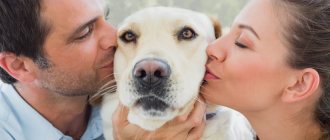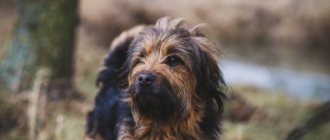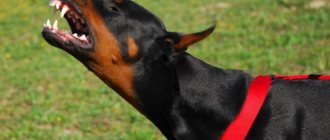Fear is based on the instinctive desire to preserve one's own life and health. In the human world, everything is more or less clear - you shouldn’t walk on the roof, dive into unexplored places, wander down the street on a dark night, etc. In the world of dogs, the system of interaction with the environment is based on trust and experience. If the pet knows the creaking tree standing in the yard, he has examined it more than once, and even marked it, then the sudden noise of the branches will not cause fear. However, what to do if the dog is afraid of the owner, that is, you? The problem must be solved as quickly and loyally as possible, since a frightened animal can be dangerous both for others and for itself.
The main mistakes of dog breeders
Let's look at some mistakes that dog breeders can make when raising a tail.
Encouraging Fear
Trying to calm the animal, the owner begins to feel sorry for the four-legged animal, help it hide from frightening stimuli, pick it up, stroke it and talk to it affectionately. Under no circumstances should this be done.
Such signals only help convince the animal that something terrible is happening. The dog believes that it is behaving correctly by trying to hide. The dog is afraid. This only intensifies the panic.
The owner begins to scold the pet
If a dog is afraid of something, you cannot scold, much less beat, the four-legged dog. This will keep the little dog from being afraid of extraneous sounds. He will not understand at all why he is being scolded. But on top of that, he may also begin to fear his owner.
The nature of fear of people
Most dogs experience panic fear of a specific person, a representative of a certain group of people. This feeling, for example, can be caused by representatives of a certain profession, dressed in a uniform, having a certain smell. This is a consequence of pain caused in the past, resentment from such a person.
Pets are often afraid of veterinarians, since a visit to a veterinary hospital was associated with discomfort and pain. If your dog has ever been hit by a bicycle, he may be afraid of this type of transport.
The dog is afraid of the street
This is a very common fear. The dog is afraid of various loud sounds from passing trucks, tractors, buses and trams.
The animal experiences enormous stress from the roar and rumble of these monstrous “monsters” and from their terrifying, menacing appearance. It tries to break free and run away “at breakneck speed.” And this can lead not only to the fact that, having run a huge distance out of fear, your pet will get lost and will not be able to return home, but also, if it gets under the wheels of a car, it may die.
To prevent this from happening, you need to accustom your dog to the street from a very early age.
Take your pet for a walk on noisy, busy streets. Start these walks with a few minutes, gradually increasing the time of walking every day. This is the only way your furry friend will sooner or later get used to it and stop experiencing stress.
When a dog is afraid of transport, you need to act in exactly the same way. Take the tailed one on a tram or bus. Drive one or two stops without reacting in any way to the four-legged fears.
Pity is of no help to you in such matters. Only patience, time and daily training will bring positive results.
This is exactly the fear we faced when our Jackusik was very small and we just started taking him outside. I tried to walk with him as often as possible, closer to the roadway. He shied away from everything. From a passing tractor, the rumble of a tram and just a sudden sharp sound. He started to panic and pulled me into the yard, where there was no this terrible noise. But I did not follow his lead and stubbornly continued to go out every day to the street that frightened him. And, I must say, he very quickly got used to it and stopped paying attention to such irritants.
New home training basics
In the new home, the pet will have to get to know the rest of the family and explore the territory. Be sure to help him at this stage and do not forget to allocate a personal space where he can be alone.
Meeting all family members
Before you get a four-legged friend, be sure to coordinate your plans with the rest of your household. The decision must be mutual. This is the only way your pet can live in a comfortable atmosphere.
Children get along best with animals, but sometimes they go too far. Babies are too intrusive and do not always calculate their strength when hugging. Talk to your child about the rules of communication before the arrival of a new family member.
Meeting other four-legged animals can make old-timers jealous, so it’s best to keep them at a distance for the first week. Try not to show affection to the newcomer in front of them and not to change your usual attitude towards your pets.
Getting to know the house
Remove all fragile, valuable and potentially dangerous items in advance. Buy more toys and leave them on the floor. This way, the pet will be able to not only sniff the new territory, but also taste some objects.
When getting to know the house, base it on the dog's behavior. If he is clearly interested, do not stop him from exploring the new environment, and if he is constrained and passive, do not insist on walking around all the rooms and give him time.
Setting up a place for a new pet
Each pet should have its own place where it can rest and be alone. Choose the quietest corner and place a comfortable bed or house in it.
During the first week, feed separately from other four-legged animals to avoid food aggression.
Buy your pet a personal feeder and water bowl so that he can get used to the new smells. Increase the portions themselves gradually, avoiding indigestion from an unusual diet.
If you have adopted a puppy, be sure to provide him with a place to go to the toilet. Use a diaper or litter tray.
The dog is afraid of firecrackers and fireworks
If your dog is afraid of firecrackers and fireworks, it is important that the owner remains calm and balanced. In your pet's eyes, you are the leader of the pack. And it is very important that, looking at you, the dog understands: the leader is not afraid, which means I have nothing to fear.
If fireworks find you at home
If fireworks catch you at home, remain calm and sit the dog next to you, at your feet. Do not calm the animal. Command: “Near!”, “Sit!” and, holding the pet, remain in this position until the end of the volleys.
Don't let the tail change position or go anywhere. It’s better to let your pet concentrate on following the command than on his fear of the roar of gunfire.
At the end of the shots, praise the dog and give it a treat. Another way to prevent an animal from panicking is to distract it from the volleys by playing together.
Turn on the music, start dancing, jumping, take your pet's favorite toy and involve him in the game. Ignore panicky behavior and do not try to calm the animal. Our Jack, for example, really loves these rubber squeaky toys.
As a rule, we most often encounter volleys of fireworks on New Year's Eve. Read more about how to help and protect your pet at this time.
If fireworks caught you on the street
If the fireworks show catches you on the street, make a short leash and command: “Nearby!” Ignoring the four-legged's fears, continue moving.
No matter how your four-legged friend learns to calmly react to shots, do not forget about the safety measures:
- Try to walk your pet before dark, when the likelihood of fireworks being set off is especially high.
- Make sure your ammunition is strong enough.
- Be sure to make an address book indicating your phone number and the dog’s name in case it suddenly gets scared and runs away.
How to train a dog to shoot shots
If your dog is afraid of firecrackers and fireworks, you need to try to accustom him to these sounds. Try this:
- Buy some firecrackers.
- First, take your ponytail for a walk, try to be active in order to take as much energy from your four-legged dog as possible.
- Go with your pet to a sparsely populated place where no one will bother you.
- Put a collar on your dog, take him on a short leash and sit him down.
- Light the firecracker and throw it at a safe distance.
- If the dog changes position or gets up, immediately put it back in place.
- Throw 3-4 firecrackers in one session, taking a break of about a minute between throws.
- Repeat this exercise every day until your pet responds calmly to these sounds.
Peculiarities of the psyche of a street animal
Adaptation of an adult dog is always more difficult. If it came to you straight from the street, the level of difficulty increases by 2 times. And we are not talking about possible infections or parasites here. A veterinarian and modern medications can handle them. The main problem that you will have to face is excessive vigilance, manifested through fearfulness or aggressiveness.
How to deal with fearfulness
In fright, the dog tucks its tail and ears, almost touches the floor with its belly and whines pitifully. Attempting too close contact may result in a sudden escape in an unknown direction, so adhere to the following steps:
- Move towards the animal until it tries to retreat or growl. Usually you have to leave at least 3-4 m.
- Having fixed a safe distance, stop and try to establish contact. If there is no open aggression, squat down. Being close to the ground will reduce potential danger.
- Try not to make eye contact. Such a signal is perceived as a challenge, so at best the animal will simply run away.
- Get attention with your voice or the snap of your fingers. Continue to speak in a calm and encouraging voice.
- If the dog is in no hurry to approach you, but is wagging its tail, slowly extend your hand towards it, palm down. It is best to squeeze it in your fist, holding something tasty and aromatic.
- When you notice interest, carefully turn over and open your palm to show off the treat.
If the future pet is too shy to take food the first time or runs away at one of the first points, do not be upset and repeat the introduction the next day. Over time, he will realize that you are not a threat and will agree to follow you.
Having overcome the stage of acquaintance, the four-legged friend will need to be accustomed to a new home and interaction with society. Build trust in people, starting with yourself. Please be patient and understanding. Try to avoid loud voices, harsh sounds and any negative emotions. For comfortable adaptation, pay enough attention to affection, joint games and walks.
How to deal with aggression
The introduction itself and the first attempt to gain trust are identical to the first option, but with a few exceptions. Aggression is one of the symptoms of rabies, so make sure there are no other signs of infection before exposure.
Also try to stay on your feet. If you are in an aggressive mood, positioning yourself too low can provoke an attack. Remember that skin-to-skin contact should be avoided until the wagging tail is visible. Only after this can you extend your hand with a treat, and only then try to stroke it. But not on the head! There are many nerve endings on it, so such a touch may be unpleasant. It’s better to gently touch the muzzle or scratch the neck.
If the aggression persists and attempts are made to attack, do not persist and leave the dog alone. In this case, the option is yes: try another day or abandon your idea. If your psyche is severely traumatized, then you cannot do without the help of a zoopsychologist.
At the time of accustoming to a new home, it will be difficult to meet other people and strengthen your authority. Aggressive dogs are characterized by dominant behavior, and they express any dissatisfaction with a threatening growl or bite. This requires discipline, developed through regular training. It is better to contact a dog handler.
The dog is afraid of other dogs
If your dog is afraid of other dogs, this indicates that your pet is unsocialized. This means that as a puppy, your pet had little contact with its own kind.
The more an animal communicates with its relatives, the more experience of such communication and behavior in a pack appears. Find four-legged friends. It is important that these are different dogs, so that the puppy does not get used to communicating only with one particular animal.
Choose non-aggressive four-legged animals so that your pet does not become even more withdrawn and afraid. Take toys for a walk, leave the ball, and let the dogs have fun running after it. This way the dog will understand that when he meets a strange dog, he can have fun playing and will no longer be afraid of other dogs.
Don't react to signs of cowardice. Praise for courage, and strictly command for aggression: “Ugh!” By the way, you can teach your dog basic commands yourself.
Puppy adaptation
If the adaptation of an adult dog takes on average several months, then a few weeks or even days are enough to tame a puppy. To do this, fulfill the following conditions:
- Protect your baby from four-legged family members with a pronounced territorial instinct using a transparent partition. This way, all inhabitants can get used to each other’s smell and appearance without direct physical contact.
- Give your new pet a personal corner with everything he needs. Expand the accessible area gradually to avoid puddles throughout the house.
- Entertain your puppy with active games and try not to leave him alone.
- Instill rules of behavior from day one. Use a diaper, feed strictly by the hour and in one place.
Avoid punishment using brute force and yelling. This method of influence will not give the desired result and will only scare the baby.
The dog is afraid of people
What to do if your dog is afraid of people? Fearing a person, an animal can react in the following ways.
Showing fear, hiding in a corner
If, showing fear, your pet hides in a corner, do not try to force it out of there, and especially, do not yell at it under any circumstances. This will only make the situation worse.
This is where persuasion and affection will help. Calm the dog down, show him that you are with him and support him.
Ask someone you know to come visit you. Let your friend talk to the dog and give it a treat. This is the only way the dog will understand that it is not in danger.
Shows aggression
There are different types of aggression in dogs. Each type of aggression must be considered individually in order to identify exactly the aggression that is inherent in your pet. Read about aggression in dogs.
Experiencing fear of a person, a dog often also begins to show aggression. Moreover, it very rarely happens that an animal is afraid of absolutely all people.
Usually the four-legged animal cannot stand the company of any one category of people. These could be men, drunk people, people with external signs unusual for a dog (for example, a man on crutches or a grandmother with a stick). And there are reasons for this. Probably, at some point in the animal’s life, the person whom the dog is afraid of offended or frightened the four-legged animal.
The adaptation process can take a long time. In any case, you must not forget: in order to wean a dog from being afraid of people, you need to surround it with love and care. And under no circumstances should you scold the tailed one.
To summarize, I would like to note a few basic rules for overcoming a dog’s fears.
Training an adult dog
After your pet gets used to you, start training. With the help of teams, it is much easier to stop unwanted behavior and instill good habits.
Selfeducation
Be consistent and patient when learning basic commands. Don’t overload with long activities and be sure to reward success with tasty treats, praise and affection.
Try to conduct training in a playful way to arouse real interest in the process. Start with leash training and the command “Near.” Go to prohibition commands (“Fu” and “Don’t”) at the very end, so as not to cause rejection too early.
Appeal to the dog handler
For the convenience of your four-legged pet, it is recommended to enroll in UGS or OKD courses, where an experienced dog handler will handle the training. If he is more than a year old, then it is better to choose individual lessons that exclude distractions from extraneous stimuli. Thanks to regular training, you can raise a dog that is smart, adequate and not dangerous to others.
Mutts with a difficult past, taken into a loving family straight from the street, are the most devoted and faithful four-legged friends. Despite the difficulties in taming, the final result exceeds all expectations, so do not be afraid to take responsibility for a stray dog.
The article is of a recommendatory nature. Contact a specialist!
Do you like the article? 167
Basic Rules
Try following these rules of conduct:
- Never punish a dog if it is afraid of something.
- If the dog is afraid of street noise or gunshots, do not give in to the four-legged panic behavior, do not feel sorry for him or try to calm him down. All these signals only help convince the animal that something terrible is happening, and it behaves correctly, trying to hide. This only intensifies the panic.
- Show indifference to firecrackers, distract your dog by playing together or focus on following the command.
- If during a panic the animal is not prone to diarrhea, feed the tail. A full stomach has a calming effect.
- If shots catch you on the street, remain calm and do not let your dog off a short leash and follow the given direction.
- Take safety precautions. Check the durability of the ammunition and the presence of an address card.
If your dog is afraid of something, only daily exercise, patience and love for your four-legged friend will bring positive results.
Take care of your pets!
Aggressive response to fear
Impulsive natures, choleric people, sanguine people do not run away when a feeling of fear appears. On the contrary, they immediately rush to an object that evokes negative emotions. If a dog not only barks at strangers, but also uses its teeth, it will not be possible to cope with such a pathology without a dog handler. Professionals know how to correct the behavior of such dogs.
If the pet barks, growls, but does not take active actions, you need to calmly and confidently approach him, take him by the collar and lightly pull him, give the command “quiet”. If this measure does not have the desired effect, you should squeeze the dog’s sternum with your knees and hold it until the object that caused the dog’s aggression leaves. Then you need to sit him down, sternly but calmly say “ok”.
You cannot pet or praise your pet when it is aggressive. If such inappropriate behavior appears, it is necessary to begin intensive socialization. Regular walks will be an important point. Gradually, you need to change walking areas from deserted ones to areas with active traffic, so that the dog gets used to it and understands that strangers do not pose a danger to it. A prerequisite is a friendly attitude towards the pet, calm, confident behavior in all situations.
Fear of stairs, entrances, elevators
Fear of stairs, entrances and elevators is associated with a lack of experience. Seeing such unusual objects for the first time, the dog may not trust them. Food reinforcement, play, and gentle nudges help to cope with phobias. Here you need to focus on individual reaction.
Special attention should be paid to older dogs. Due to problems with the musculoskeletal system, it is difficult for them to move up stairs. If the pathology is confirmed, carry your pet in your arms. For large breeds, it is recommended to use a harness with a handle.











